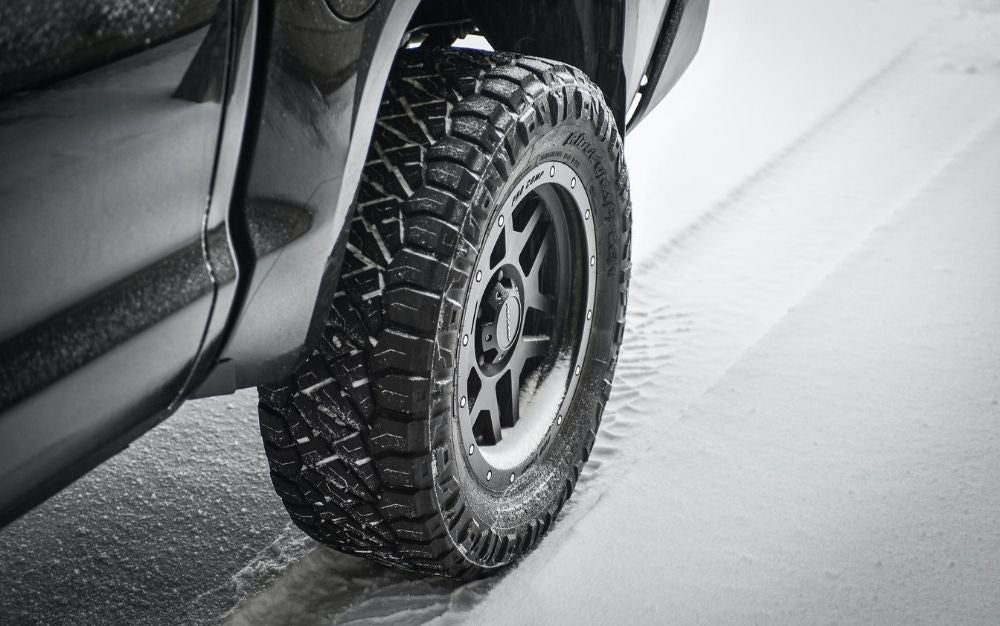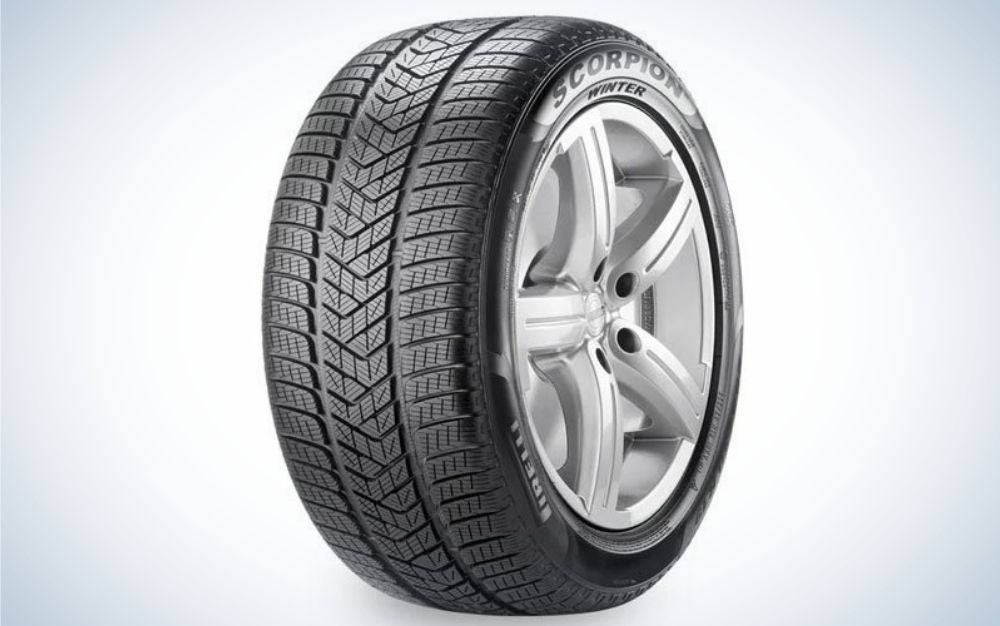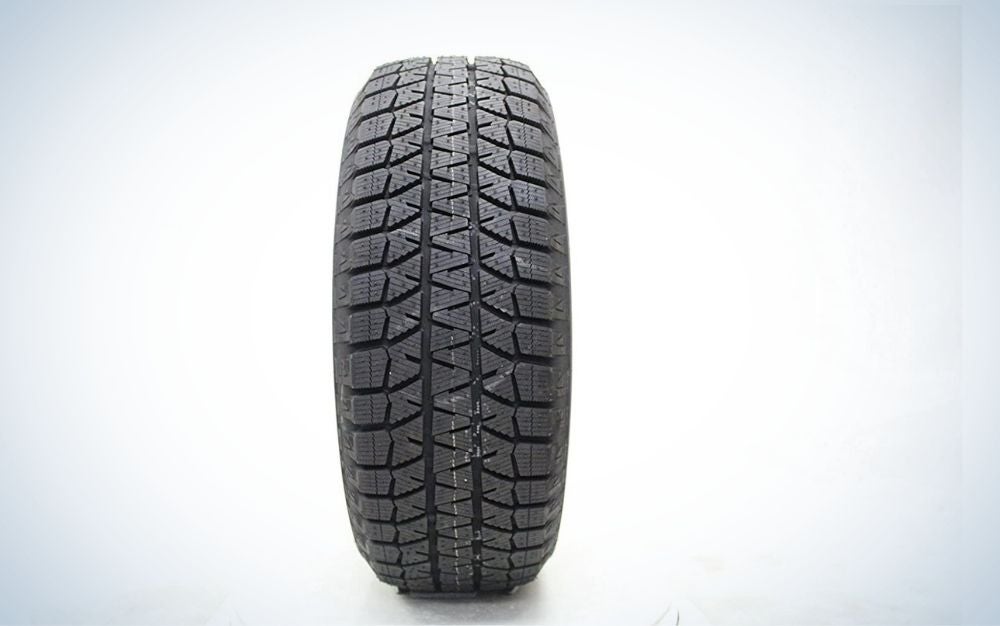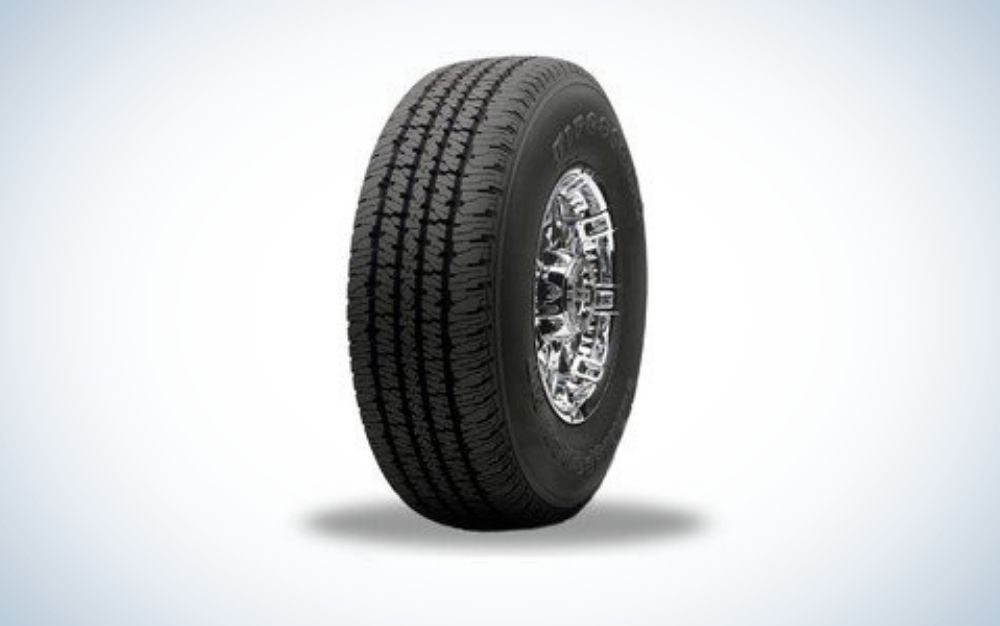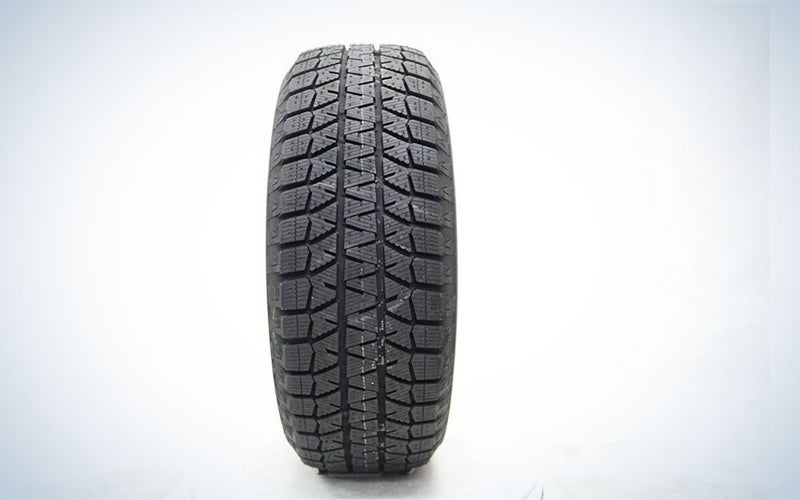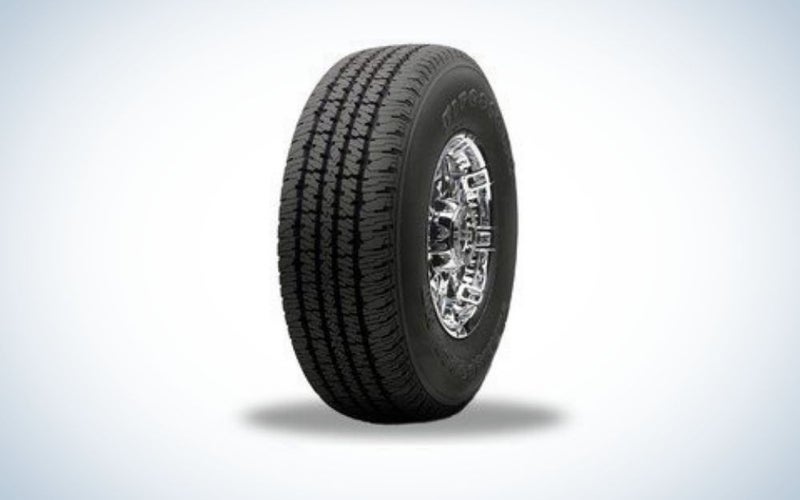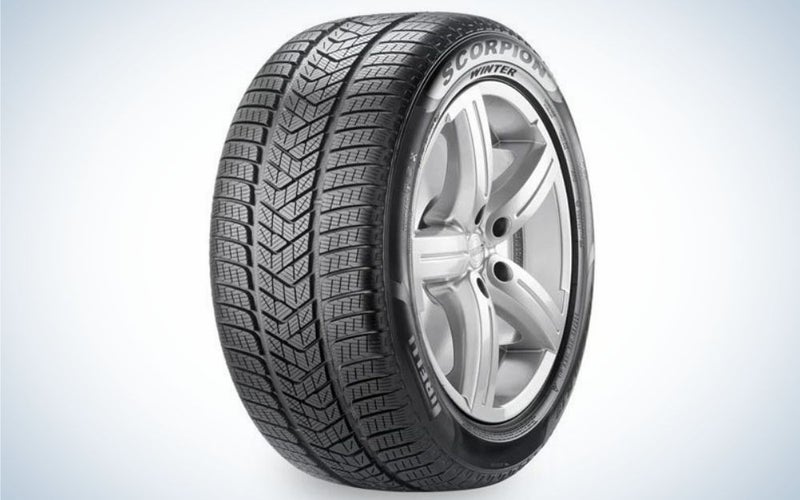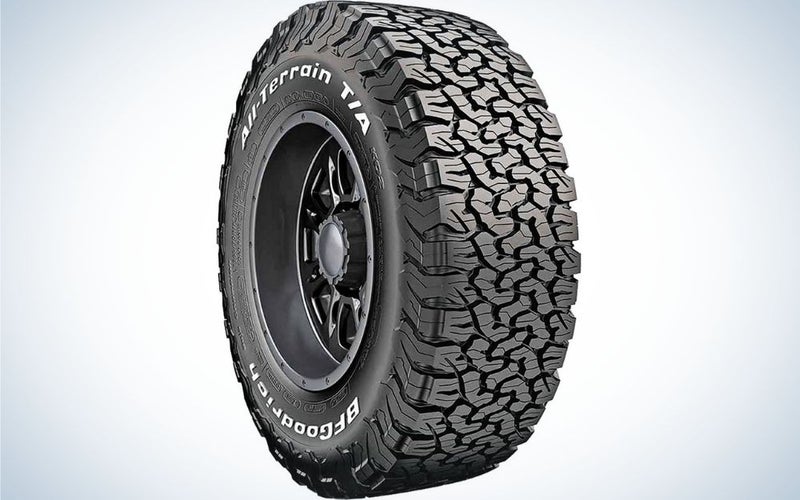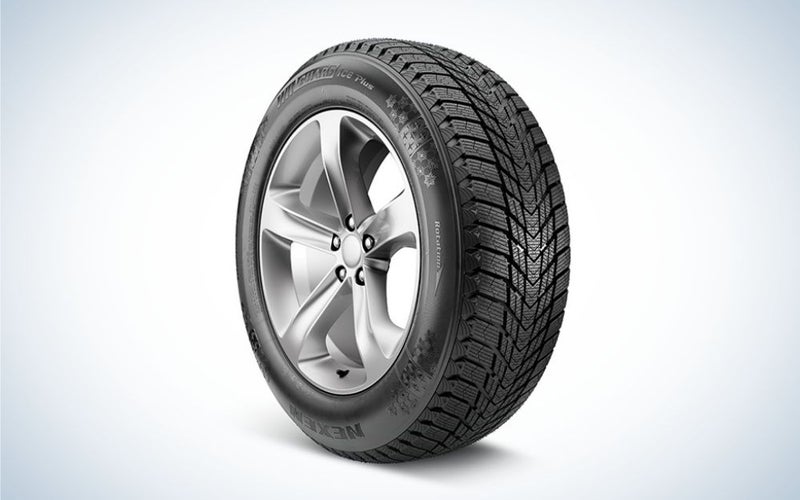We may earn revenue from the products available on this page and participate in affiliate programs. Learn more ›
Stop slipping and sliding during the cold winter months and arm your car, truck, or SUV with proper snow tires. The best snow tires are more rugged than all-season tires and have the specialized treads needed to clutch the road during harsh conditions. But with so many car tires available, how do you know which tires offer great snow performance and which will be a waste of money? Understand how these tires for snow work and learn what to look for when shopping for these unique rubber lifesavers. From affordable options to get you through the winter to more robust snow tires for those living in a permanent winter wonderland, here’s how you can find the right tire at the right price for the right terrain.
- Best for cars: Bridgestone Blizzak WS90 Winter Tire
- Best for light trucks: Firestone Winterforce LT 225 Winter Snow Tire
- Best for luxury crossover vehicles: Pirelli Scorpion Winter P265 Winter Tire
- Best for off roaders: BFGoodrich All-Terrain Tire LT285
- Best budget: Nexen Winguard Ice Plus Winter Snow Tire
The best snow tires: Reviews & Recommendations
What makes the best modern snow tire the best? It must be up to the job, whether it’s picking up groceries or picking up tree trunks. The type of vehicle and the specific tasks you want to accomplish should be the first things to think about when shopping. Thankfully, most online retailers provide search tools that pinpoint the type of tire you’ll need.
Best for cars: Bridgestone Blizzak WS90 Snow Tires
Bridgestone
You wouldn’t wear flip flops in a snowball fight, and shouldn’t trust standard tires in winter weather. Even if you only need to drive to the office and back, Bridgestone Blizzak tires can make a world of difference. They are great on snow and even better on wet slush, channeling the winter weather away from the tire. And when you need to stop suddenly, the Bridgestone snow tire is dependable. Solid ice will still be slippery with these tires, but for typical suburban roads it’s tough to beat the traction.
Best for light trucks: Firestone Winterforce LT 225 Winter Snow Tire
Walmart
Firestone is known for their high-quality tires and the Firestone Winterforce LT series is no different. The Firestone Winterforce LT 225 Winter is rated for severe snow service equipment and excels at clinging to the road in deep snow. It’s also pretty good on light snow and slick surfaces. You can add studs to the tire for even greater traction. And for a truck tire, it isn’t prohibitively expensive. The Firestone snow tire is good for light trucks and SUVs that need to navigate through more than flurries.
Best for luxury crossover vehicles: Pirelli Scorpion P265 Winter Tire
Walmart
The Pirelli Scorpion winter tire is perfect for drivers who need to get to job sites even in snowy conditions. They can handle a load of 2,337 pounds, and are relatively quiet. While on the pricey side, Pirelli snow tires are made of durable material that will last for several winter seasons. They handle great in deep snow, dry roads and everything in between. Even ice isn’t much of a challenge for these PIrelli tires. They can turn a luxury SUV such as an Audi SQ5 into a winter-weather driving machine.
Best for off-roaders: BF Goodrich All-Terrain T/A KO2 Tire
Walmart
All-terrain tires, like all-season tires, are not specifically designed for snow. But the BF Goodrich tire can handle mud and dirt just as well as snow and ice. The molded aggressive tread bites into snow without issue, and handles well even on dry asphalt. If you want to go on winter adventures through windy mountain roads, the BF Goodrich all-terrain tire will make the journey easier and safer.
Best budget: Nexen Winguard Ice-Plus Winter Tires
Walmart
What can you expect from cheap ones? Surprisingly good winter weather traction. These Nexens are not made for high-speed, high-performance snow driving. But for those who keep it under 100mph and still want to travel through wet winter weather, these do a pretty good job. Cheaper tires won’t last as long, so it’s a good thing the tires are affordable. If you’ve never used snow tires and want to see if they make a difference, this is a good entry-level product at a great price.
What to consider when shopping for the best snow tires
Just because it says “snow tire” on the label doesn’t mean it’ll be a great fit for your vehicle. Look for specific thread types and features that will work for your environment. But don’t get overwhelmed by stats. They are not as complicated as they appear.
Why choose snow tires? Better gas mileage and safety.
The biggest benefit of any snow tire is its handling in winter weather. When snow, ice, slush, or water cover the driving surface, a tire for snow will send precipitation flying away from the wheel. They’re designed with more tread depth and grooves to prevent hydroplaning; you’ll notice a difference between one for snow and a regular tire when making turns and coming to a complete stop.
They also offer more than safety on winter roads. They also increase gas mileage. When standard tires slip and slide on snowy surfaces, your vehicle isn’t getting the optimal gas mileage. And if the tire is underinflated, it only makes things worse. They are designed to cling to the road, giving you proper traction and increasing gas mileage. They are also designed to work in sub-zero temperatures.
While the result may be minimal, those extra miles-per-gallon will add up over time. If you’re worried about the cost of the tires, factor in the bonus gas mileage—a good investment in safety becomes a good investment in fuel economy.
For the best snow performance shop for aggressive tire tread patterns.
The treads and channels in the snow tire are engineered to move water and snow out of the way. The deep cuts and serrated voids on the rubber surface is what separates a snow tire from a regular tire. Thanks to the jagged cuts and small holes that suck up water, dedicated tires for snow are much better at grabbing the road than so-called all-season tires.
How do you know if the tread will really stand up to a storm? Look for the Three-Peak Mountain Snowflake (3PMSF). This mountain icon will appear on the sidewall of a tire rated for snowy conditions. It’s a good place to start when considering snow-tire specs.
For serious driving in areas where winter weather is the norm, you should look for an aggressive tread pattern. These dramatic saw-tooth designs are better at maintaining traction. They still have the 3PMSF certification, but go above and beyond other all-season tires. Put another way, not all 3PMSF-rated tires will be great for blizzard conditions and deep snow. Make sure the product is labeled as a winter tire, not just an all-season tire. And for even more gripping power, you may want to consider studded tires.
You can also try tire sipping. Tire sipping means making small cuts into the tire for better handling. Some auto shops will sip your tires for you. While tire sipping won’t turn a regular tire into a winter-rated tire, it may increase traction a bit.
When to use studded tires and when it’s illegal
Metal or rubber studs can be added to specialized snow tires. These tiny nuggets extend past the tread and help the tire grab onto icy roads. For those who drive on ice, a studded tire can make a huge difference in how the vehicle handles. If you want substantial snow performance, studs are the way to go. But the studs do have drawbacks.
First, and most importantly, studs are not permitted everywhere. Only six states (Colorado, Kentucky, New Hampshire, New Mexico, Vermont, and Wyoming) allow drivers to use studs without restrictions. Other states have date restrictions (fall to spring). And some states ban studs altogether. Why? Because the studs are great on snow and ice, but destructive on dry asphalt and cement.
Second, studs need to be installed, which can take time. Each stud is attached to the tire with a stud gun into pre-designated holes. You cannot add studs to any tire. Only those made for studs can handle the added prongs.
And third, studs are noisy. While you may not notice it, everyone around you will. Studded snow tires can be great for some locations and emergency vehicles, but are not ideal for every driver.
Make sure the tires are suited for your truck
If you drive a truck, keep in mind that not all truck tires are the same. Light service trucks won’t need the same tire as a heavy-duty pickup. Depending on the size of your truck and the load you’re carrying, you will need specific tires made for snow. For those driving a lifted truck (with modified suspension for big tires) hauling large loads, you may need studded tires for proper handling. Regular snow tires won’t be up to the challenge.
If you’re more concerned with speed than snow, you can opt for a performance tire. These all-season tires lack the snow-crunching tread of snow tires, but can do a fair job on wet and slushy roads.
Affordable tires don’t necessarily mean you sacrifice quality
Tires can be expensive, but you should be able to find high-quality options that won’t break the bank. Cheaper ones can be just as good at trekking across the winter road. The big drawbacks are that the tread won’t last as long, the tire will be made of slightly weaker material, and they’re probably not ideal for big trucks. But for driving a car or SUV, cheaper snow tires can still be a useful alley in the war against winter.
FAQs
Q: How do I choose winter tires?
To choose winter tires, start by looking at your current vehicle. You need to find a snow tire that fits your car, truck, or SUV. Next, find one that suits your environment. Studded tires are great for trucks driving through harsh climates that are covered with snow most of the year. But for a sedan driving in an area where the winter season lasts only two months and snow plows are plentiful, you probably won’t need studded tires. And finally, buy snow tires in sets of four. You do not want your car to have one snow tire and three standard tires. An unbalanced car will be difficult to handle and will cause wear and tear on the suspension and axles.
Q: How to check tire tread?
To check tire tread, get a quarter and stick George Washington upside down into the tread. If the tread doesn’t reach Washington’s forehead, it’s time for a new tire. The coin trick is a handy rule of thumb, but for more accurate tread measurement, you can buy a specialized gauge. When the tread dips below the 2/32-inch mark, the tire will be losing performance and it could make for a dangerous drive, especially in the snow.
Q: Do you need snow tires with AWD?
Yes, snow tires can help with AWD. All-wheel-drive vehicles have little trouble maneuvering through light snow, but heavy snow and ice require more substantial tires with snow-specific tread. It’s a common misconception that AWD vehicles are automatically winter-ready. But tires made for snow will allow an AWD truck to crunch through two feet of snow or more, so they can be well worth the money.
The final word on the best snow tires
- Best for cars: Bridgestone Blizzak WS90 Winter Tire
- Best for light trucks: Firestone Winterforce LT 225 Winter Snow Tire
- Best for luxury crossover vehicles: Pirelli Scorpion Winter P265 Winter Tire
- Best for off roaders: BFGoodrich All-Terrain Tire LT285
- Best budget: Nexen Winguard Ice Plus Winter Snow Tire
Fight back against winter weather with high-quality options. The best snow tires will be built to channel water and slush and prevent snow from building up in the tread. And with optional metal studs, your car, truck, or SUV will be ready for blizzard-like conditions. (But before you opt for the studs, make sure they are permitted in your area.) No matter what type of vehicle you’re driving this winter, the proper tires for snow make sure the season is safe and manageable. Add the best windshield snow cover to your shopping cart, and you’re all set for this winter!
Why trust us
Popular Science started writing about technology more than 150 years ago. There was no such thing as “gadget writing” when we published our first issue in 1872, but if there was, our mission to demystify the world of innovation for everyday readers means we would have been all over it. Here in the present, PopSci is fully committed to helping readers navigate the increasingly intimidating array of devices on the market right now.
Our writers and editors have combined decades of experience covering and reviewing consumer electronics. We each have our own obsessive specialties—from high-end audio to video games to cameras and beyond—but when we’re reviewing devices outside of our immediate wheelhouses, we do our best to seek out trustworthy voices and opinions to help guide people to the very best recommendations. We know we don’t know everything, but we’re excited to live through the analysis paralysis that internet shopping can spur so readers don’t have to.
